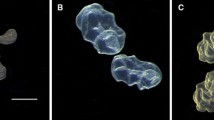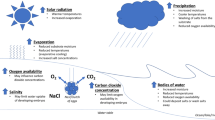Abstract
Dormancy, the physiological start of rest, occurs in numerous animal species. Many crustaceans release various types of encased embryos in a state of dormancy (e.g., cysts, ephippia, etc.). These dormant propagules require specific combinations of abiotic environmental cues to terminate dormancy. Our goal was to determine if population-specific responses to varying levels of salinity and light (photoperiod) would be present in dormancy termination of the brine shrimp, Artemia franciscana, from distinct environments. Therefore, we cross-factored different salinity concentrations and photoperiods with three A. franciscana populations collected from geographically distinct environments. To measure population-specific response, hatching success (i.e., hatching percentage) was calculated for each treatment. Our results supported the hypothesis that diverse populations of A. franciscana do have population-specific responses to photoperiod and salinity ranges, which affect hatching success (e.g., a population from Portugal showed the greatest hatching success at a salinity of 50 g/l, while populations from Spain and the U.S.A. exhibited the greatest hatching success at 25 g/l). These population-level differences should be taken into consideration during experimentation, especially when examining hatching success in this model organism.



Similar content being viewed by others
References
Amat, F., F. Hontoria, O. Ruiz, A. J. Green, M. I. Sánchez, J. Figuerola & F. Hortas, 2005. The American brine shrimp as an exotic invasive species in the western Mediterranean. Biological Invasion 7: 37–47.
Baruah, K., H. P. P. D. Phong, P. Norouzitallab, T. Defoirdt & P. Bossier, 2015. The gnotobiotic brine shrimp (Artemia franciscana) model system reveals that the phenolic compound pyrogallol protects against infection through its prooxidant activity. Free Radical Biology and Medicine 89: 593–601.
Brendonck, L. & L. De Meester, 2003. Egg banks in freshwater zooplankton: evolutionary and ecological archives in the sediment. Hydrobiologia 491: 65–84.
Black, A. R. & S. I. Dodson, 2003. Ethanol: a better preservation technique for Daphnia. Limnology and Oceanography: Methods 1: 45–50.
Boileau, M. G., P. D. N. Hebert & S. S. Schwartz, 1992. Non-equilibrium gene frequency divergence: persistent founder effects in natural populations. Journal of Evolutionary Biology 5: 25–39.
Cano, I., B. Lopez-Jimena, E. Garcia-Rosado, J. B. Ortiz-Delgado, M. C. Alonso, J. J. Borrego, C. Sarasquete & D. Castro, 2009. Detection and persistence of Lymphocystis disease virus (LCDV) in Artemia sp. Aquaculture 291: 230–236.
Clegg, J. S., 1997. Embryos of Artemia franciscana survive four years of continuous anoxia: the case for complete metabolic rate depression. The Journal of Experimental Biology 200: 467–475.
De Meester, L., A. Gómez, B. Okamura & K. Schwenk, 2002. The Monopolization Hypothesis and the dispersal–gene flow paradox in aquatic organisms. Acta Oecologica 23: 121–135.
Drinkwater, L. E. & J. S. Clegg, 2002. Experimental biology of cyst diapause. In Abatzopoulos, T. J., J. A. Beardmore, J. S. Clegg & P. Sorgeloos (eds), Artemia: Basic and Applied Biology. Kluwer Academic, Boston: 93–117.
Ehrlich, P. R., 1984. Which animal will invade? In Mooney, H. A. & J. A. Drake (eds), Ecology of Biological Invasions of North America and Hawaii. Springer, New York: 79–95.
Hairston, N. G. & C. E. Cáceres, 1996. Distribution of crustacean diapause: micro- and macroevolutionary pattern and process. Hydrobiologia 320: 27–44.
Hand, S., 1998. Quiescence in Artemia franciscana embryos: reversible arrest of metabolism and gene expression at low oxygen levels. The Journal of Experimental Biology 201: 1233–1242.
Hebert, P. D. N. & C. C. Wilson, 2000. Diversity of the genus Daphniopsis in the saline waters of Australia. Canadian Journal of Zoology 78: 794–808.
Hebert, P. D. N., E. A. Remigio, J. K. Colbourne, D. J. Taylor & C. C. Wilson, 2002. Accelerated molecular evolution in halophilic crustaceans. Evolution 56: 909–926.
Kellogg, V. L., 1906. A new Artemia and its life conditions. Science 24: 594–596.
Kim, H. J. & A. Hagiwara, 2011. Effect of female aging on the morphology and hatchability of resting eggs in the rotifer Brachionus plicatilis Müller. Hydrobiologia 662: 107–111.
Lavens, P. & P. Sorgeloos, 1996. Manual on the pro-duction and use of live food for aquaculture. FAO Fisheries Technical Paper No. 361.
Lodge, D. M., 1993. Biological invasions: lessons for ecology. Trends in Ecology and Evolution 8: 133–137.
McMahon, R. F., 2002. Evolutionary and physiological adaptations of aquatic invasive animals: r selection versus resistance. Canadian Journal of Fish Aquatic Sciences 59: 1235–1244.
Muñoz, J. & F. Pacios, 2010. Global biodiversity and geographical distribution of diapausing aquatic invertebrates: the case of the cosmopolitan brine shrimp, Artemia (Branchiopoda, Anostraca). Crustaceana 83: 465–480.
Muñoz, J., A. Gómez, J. Figuerola, F. Amat, C. Rico & A. J. Green, 2014. Colonization and dispersal patterns of the invasive American brine shrimp Artemia franciscana (Branchiopoda: Anostraca) in the Mediterranean region. Hydrobiologia 726: 25–41.
Pancella, J. R. & R. G. Stross, 1963. Light induced hatching of Daphnia resting eggs. Chesapeake Science 4: 135–140.
Patra, S. K. & K. S. Mohamed, 2003. Enrichment of Artemia nauplii with the probiotic yeast Saccharomyces boulardii and its resistance against a pathogenic Vibrio. Aquaculture International 11: 414–505.
Quiroz, M., X. Triadó-Margarit, E. O. Casamayor & G. Gajardo, 2015. Comparison of Artemia–bacteria associations in brines, laboratory cultures and the gut environment: a study based on Chilean hypersaline environments. Extremophiles 19: 135–147.
Saleki, R., P. G. Young & D. D. Lefebvre, 1993. Mutants of Arabidopsis thaliana capable of germination under saline conditions. Plant Physiology 101: 839–845.
Sayg, Y. B., 2004. Characterization of parthenogenetic Artemia populations from Çamaltı (Izmir, Turkey) and Kalloni (Lesbos, Greece): survival, growth, maturation, biometrics, fatty acid profiles and hatching characteristics. Hydrobiologia 527: 227–239.
Shinomura, T., A. Nagatani, H. Hanzawa, M. Kubota, M. Watanabe & M. Furuya, 1996. Action spectra for phytochrome A- and B-specific photoinduction of seed germination in Arabidopsis thaliana. Proceedings of the National Academy of Sciences USA 93: 8129–8133.
Van Der Linden, A., R. Blust, K. Cuypers, C. Thoeye & F. Bernaerts, 1987. An action spectrum for light-induced hatching of Artemia cysts. Journal of Experimental Marine Biology and Ecology 92: 207–214.
Van Der Linden, A., R. Blust, A. J. Van Laere & W. Decleir, 1988. Light-induced release of Artemia dried embryos from diapause: analysis of metabolic status. The Journal of Experimental Zoology 247: 131–138.
Van Stappen, G., H. Yu, X. Wang, S. Hoffman, K. Cooreman, P. Bossier & P. Sorgeloos, 2007. Occurrence of allochthonous Artemia species in the Bohai Bay area, PR China, as confirmed by RFLP analysis and laboratory culture tests. Fundamental and Applied Limnology Archiv für Hydrobiologie 170: 21–28.
Weider, L. J. & P. D. N. Hebert, 1987. Ecological and physiological differentiation among low-Arctic clones of Daphnia pulex. Ecology 68: 188–189.
Zhou, Q., C. Wu, B. Dong, F. Liu & J. Xiang, 2008. The encysted dormant embryo proteome of Artemia sinica. Marine Biotechnology 10: 438–446.
Acknowledgements
The authors thank R. Hartnett for her intellectual contributions, technical advice, and research assistance. The authors are grateful for the research assistance provided by E. Kiehnau, B. Culver, F. L. Speer, and T. R. Ledford. The authors appreciate the Estacion Biologica Doñana for providing cyst samples used in this study. Furthermore, the authors want to express their gratitude to M.H. Hoefnagels for revisions and preparations of the manuscript. Funding for this study was provided by the U.S. National Science Foundation (NSF-IOS-OEI) Grants #0924289 and #1256881 to L. J. W. Any opinions, findings, and conclusions or recommendations expressed in this material are those of the authors and do not necessarily reflect the views of the National Science Foundation. Further, the authors thank the Joe C. and Carole Kerr McClendon Honors College, the University of Oklahoma, for the financial support. This study represents an independent research project conducted by FWS in the laboratory of LJW, in partial fulfillment of the requirements for a Bachelor of Science (B.S.) degree at The University of Oklahoma.
Author information
Authors and Affiliations
Corresponding author
Additional information
Handling editor: Andrew Dzialowski
Rights and permissions
About this article
Cite this article
Speer, F.W., Weider, L.J. Examining population-specific hatching cues of salinity and light for Artemia franciscana . Hydrobiologia 805, 391–397 (2018). https://doi.org/10.1007/s10750-017-3326-9
Received:
Revised:
Accepted:
Published:
Issue Date:
DOI: https://doi.org/10.1007/s10750-017-3326-9




